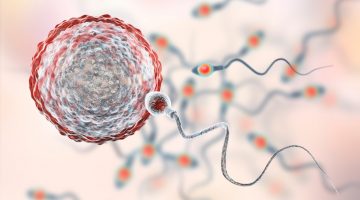IUI Success Rates

If you’re considering Intrauterine insemination (IUI) as a fertility treatment, it’s likely you’re quite curious about IUI success rates. IUI, also known as artificial insemination, circumvents the vagina and cervix to drop concentrated sperm right into the uterus where it’s closer to the egg. But how likely is this “head start” to get you pregnant? Like most answers about fertility treatments, IUI success rates depend on a lot of different factors. In this article, we will be sharing just about everything there is to know about IUI success rates, how to improve IUI success rates, and empowering the power of positivity through sharing some IUI success stories. But first, let’s start with a nice little overview before we take a deep dive.
Fast Facts about IUI Success Rates
- Across all patients types, IUI cycles have live birth rates per cycle of between 5 – 15%. But reported success rates vary quite a bit from study to study. Some studies show just an 8% success rate (using fertility drugs and IUI), while other studies find success rates over 20%. Success depends on a lot of factors, including if fertility drugs were used, which ones were used, and the age of the woman. More on all of these variables later.
- Repetition also plays a role in overall success using IUI. The more IUI cycles you undergo, the higher your chance for pregnancy. That said, multiple studies show that a VAST MAJORITY (90-95%) of successful IUIs will happen within 3-4 attempts.
- Because IUI acts only as an assistant to natural conception (in that sperm still have to swim up the fallopian tube, fertilize an egg, and then implant back in the uterus), there are many diagnoses that are contraindicated to persuing IUIs. If one attempted IUI regardless, their success rates would be near zero.
- There are many ways to define “IUI Success”, including pregnancy rates, live birth rates, and the odds of multiples.
- Because success rates vary tremendously from patient to patient and treatment approach to treatment approach it’s important to consult with a fertility specialist before taking any action.
With that, let’s head-on into the deep end.
IUI Success Rates by Diagnosis and Patient Demographics
By Age:
Outside of some specific fertility diagnoses, age is the most important factor in determining the odds of IUI success. Because conception rates drop considerably as a woman ages due to egg quality and/or many repeated IUI cycles are required in order to conceive, most fertility specialists do not recommend IUI to women trying to get pregnant at or over 40. While ideal candidates under 35 have a 15-20% per cycle chance of success, women 35-40 have about a 10% chance, and women over 40 just 5% or lower each cycle , other studies predict even lower odds.

For Patients with Ovulatory Issues or PCOS
Women who don’t ovulate (anovulation), have absent or irregular menstrual cycles, or have been diagnosed with PCOS, the most common ovulatory disorder affecting one in ten women, often require medications to conceive. While Letrozole is the preferred medication for PCOS based on a double-blind, randomized study (especially for women with a BMI over 30 kg/m2), some women have better success with Clomid, while others are resistant to both Letrozole and Clomid and require gonadotropin in order to ovulate.
IUI will only be effective in PCOS patients if the patient actually ovulates. Adding on IUI to a medicated Clomid or Letrozole cycle provides a slight bump in conception rates and makes sense especially if there is some mild male factor infertility and sperm movement isn’t ideal. If you have PCOS and require gonadotropins, IUI has been shown to significantly improve the odds of conception.

For Patients with Male Factor Infertility
Men with mild male factor infertility and their partners can benefit from IUI, but men with severe sperm problems generally don’t. This is because IUI is really a facilitator of natural conception. While IUI provides sperm with a head start by placing them in the uterus, it still requires a sperm to reach and fertilize the egg on its own. If the male partner has a low sperm count, then the chances of a sperm making it to the egg on its own are quite low. In most cases, a doctor will recommend IVF with ICSI for severe male factor infertility. If no sperm is present in the ejaculate, surgery may even be possible to retrieve sperm from within the male’s reproductive tract.
So, what’s considered mild, and what’s severe? Every fertility center has different parameters. At CNY Fertility, we don’t generally recommend IUI to patients with less than 7 million total motile sperm. A 2015 retrospective study of over 47,500 IUI cycles looked at fresh post-wash total motile sperm count (which can be up to 30% lower than pre-wash counts) and the associated conception rate. Researchers found couples with a post-wash total motile sperm count of at least 9 million had a pregnancy rate for one IUI cycle of 16.9%. If the post-wash count was above 9 million, the same chances of success were observed and did not increase. However, for patients with sperm counts lower than 9 million, success rates steadily fell.
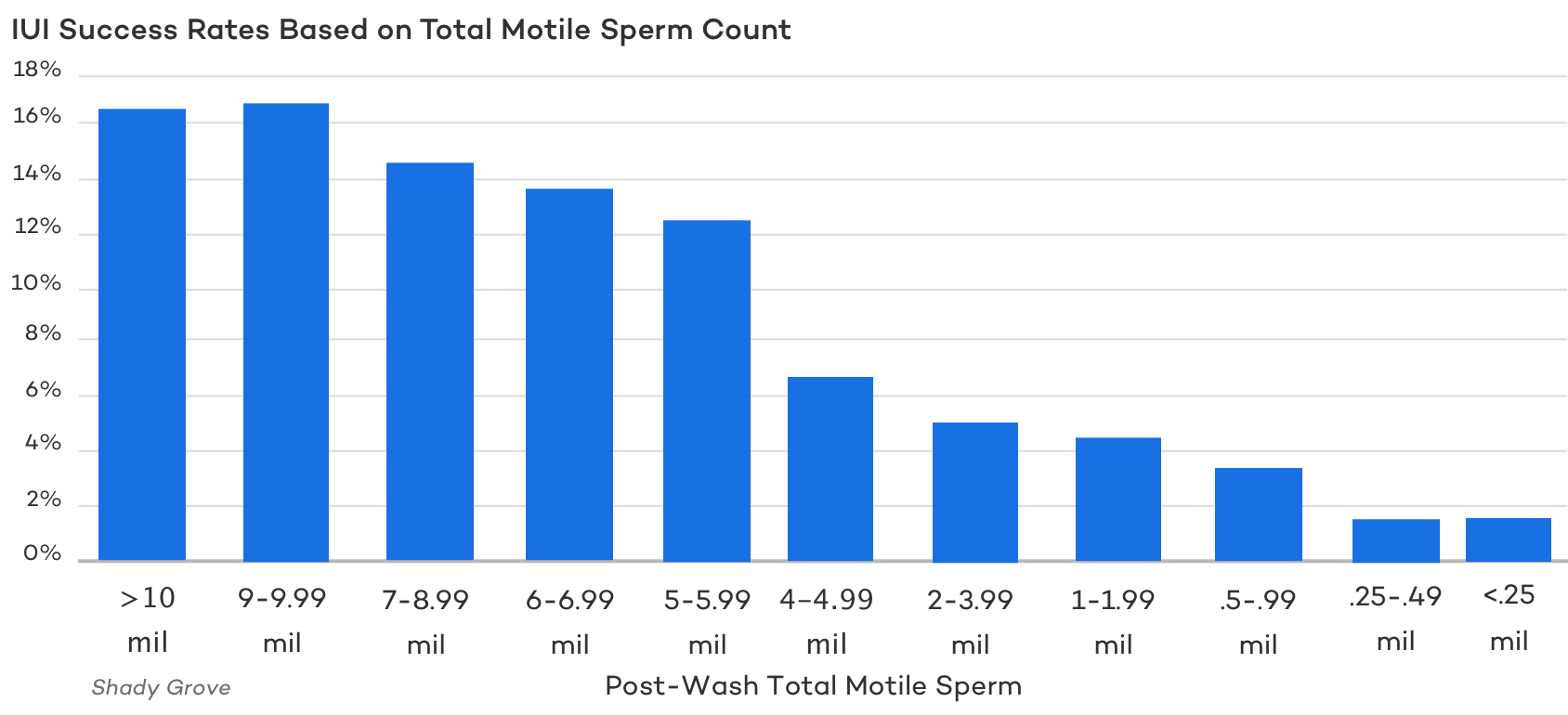
For Patients with Unexplained Infertility
A diagnosis of “unexplained infertility” usually means you have a good egg count, open fallopian tubes, a healthy uterus, sperm count within normal parameters, and no other explanation for difficulties conceiving. This group includes up to 25% of women experiencing fertility challenges. Women in this category can expect IUI success rates in the range of 7-10% per cycle. After 3 medicated IUI cycles with Letrozole or Clomid, success rates can range from 15-25%.

Single Open Fallopian Tube
Fortunately, it only takes one open fallopian tube to conceive. If a woman has one blocked tube and one open tube, pregnancy can still occur, although conception rates can vary based on where the blockage is located in the blocked tube. Women with a blockage in the distal portion (closest to the ovary) of her tube tend to not fare as well as women with a blockage in the proximal portion (closest to the uterus). This is, in part, due to the fact that hysterosalpingograms can misdiagnose a tubal blockage in the proximal portion up to 30% of the time when there is no blockage.
Women under age 38 undergoing IUI with a proximal tubal blockage and one open tube can expect to have conception rates of around 38.1% after 3 IUIs. Women undergoing IUI with a distal occlusion have around a 11.7% chance of conceiving according to one study .
Single and Lesbian Women
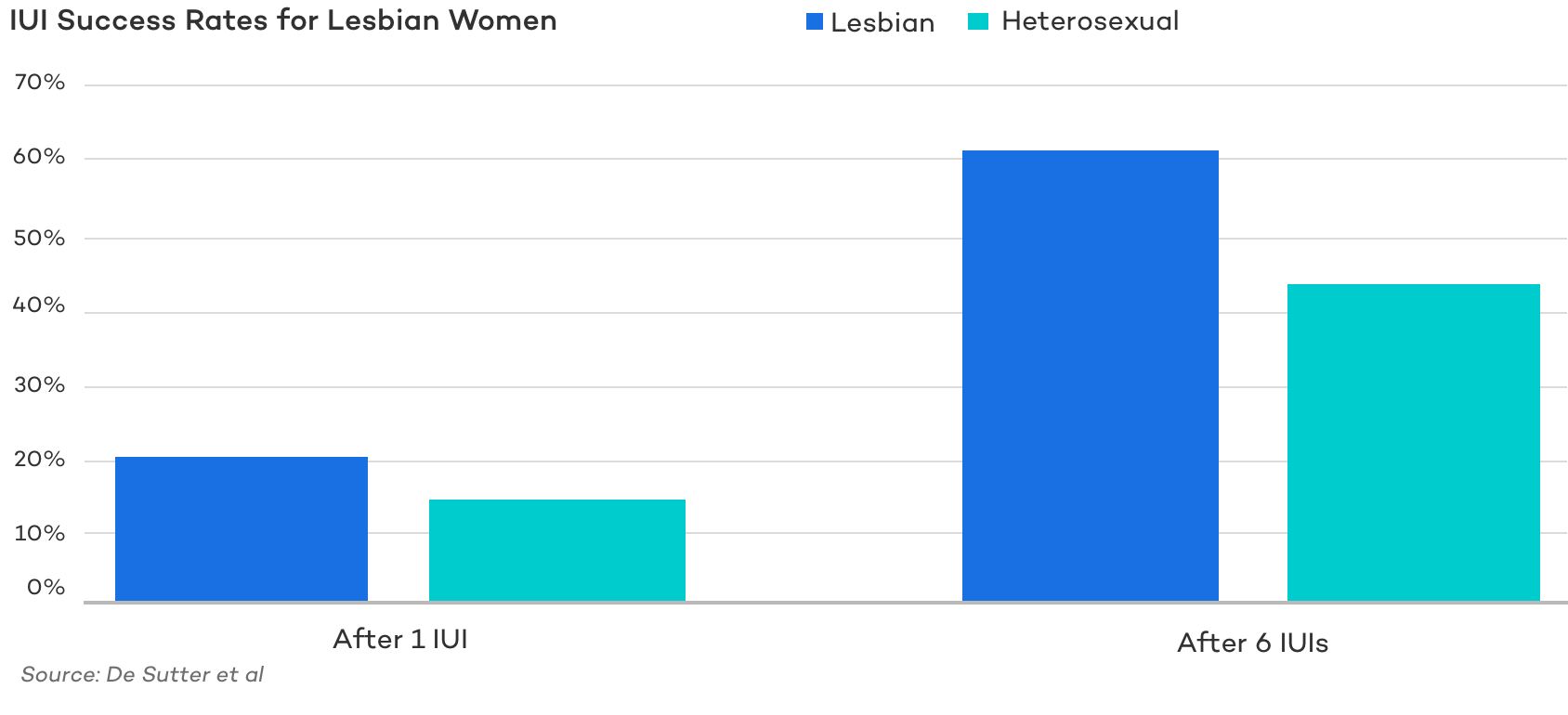
Single and lesbian women typically do very well with IUI, even unmedicated cycles, because there often isn’t an underlying fertility issue and are often using high-quality donor sperm. A 2014 study depicted above in the graph shows that lesbian women have higher pregnancy rates from IUIs. After one cycle lesbian women had a 20.5% pregnancy rate compared to a 14.8% chance of heterosexual women. After 3 cycles, that shot up to 61.6% and 44.0% respectively. Another earlier study looked at lesbian women ranging in age from 26-44 and single women age 29-47 using frozen sperm and found a clinical pregnancy rate of 57% in lesbians and 36% in single women. After 6 cycles of IUI, cumulative rates were 70% and 47%, respectively. Researchers concluded that IUI was less effective for single women in the study because they were older and likely reflected the fact that single women tend to have failed to conceive for a period of time prior to seeking treatment from a fertility specialist.
IUI Success Rate By the Number of Follicles
The goal of ovarian stimulation with medications is to produce additional follicles so that there are more eggs available for fertilization, thereby increasing the chances of conception that month. More follicles = greater chances of conceiving up to a certain point. It’s a balancing act of stimulating additional eggs, but not too many eggs that lead to twins, triplets, or even quadruplets as a result. Singletons involve much lower risk to both mother and fetus and are the goal for most doctors and fertility practices. Most women pairing a medicated cycle with IUI will not be allowed to proceed with IUI if they are growing 4 or more follicles.
Studies have shown that multi-follicular growth is associated with increased pregnancy rates in IUI with controlled ovarian hyperstimulation (COH). Be warned however that more follicles also equals a higher rate of twins, triplets, etc.
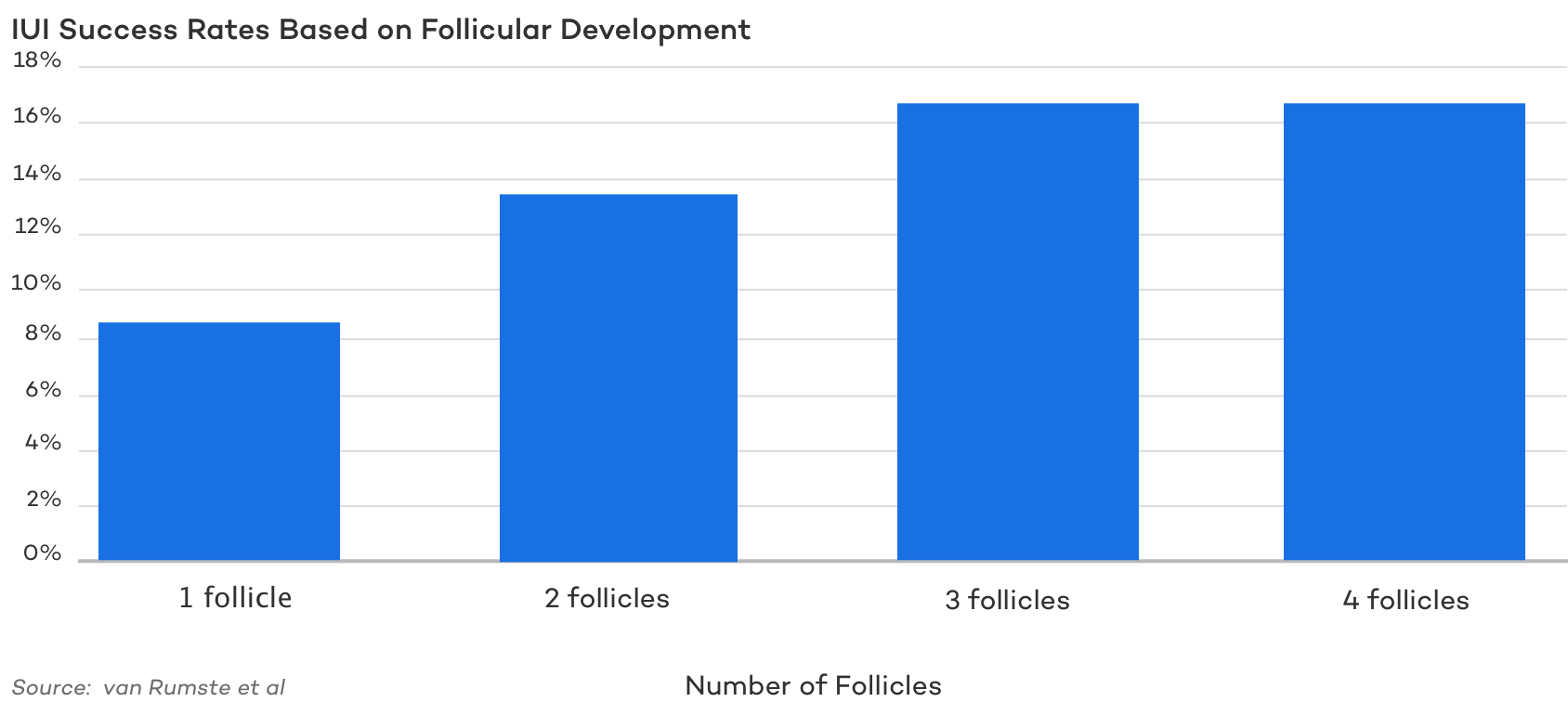
IUI Success Rate By Drug Type
Most, but not all, IUI cycles are paired with fertility medications to stimulate the follicles to produce additional eggs. What your fertility specialist recommends will be based on your medical history, diagnosis, and preferences. Using medications, the specific type, and the dosage used all affect IUI success rates.
The three main drugs used in a medicated IUI cycle are: Clomid, Letrozole, and Gonadotropin – though Clomid is no longer being used widely at many clinics, including CNY Fertility. Clomid and Letrozole are both oral medications that message the brain to send stronger signals to the ovaries to ovulate, while Gonadotropin is an injectable medication that stimulates the ovaries directly to produce more follicles. The goal is always to maximize the number of eggs (hence boosting chances for conception) while limiting the risk of multiple pregnancies.

It is however important to note that although Clomid and Letrozole have similar odds of producing a live birth, letrozole generally has fewer side effects and more importantly, produces more singleton births.
IUI Success Rate Comparing Fresh vs. Frozen Sperm
Both fresh and frozen sperm can be used successfully with IUI. When fresh is an option, it is preferred. In part, because there is an expected loss of sperm in the thawing process, but also because timing is even more critical with washed thawed sperm. Washed fresh sperm survive about 24-36 hours, while washed thawed sperm only have a lifespan of 12-24 hours. Fresh sperm tend to live a bit longer which can improve the chances of conception. One study compared pregnancy rates using fresh sperm versus cryopreserved sperm for IUI. After one cycle, pregnancy rates were higher for fresh sperm vs. frozen (21.2% vs. 15.8%) and this trend continued through 3 cycles (48% fresh vs. 22% frozen).
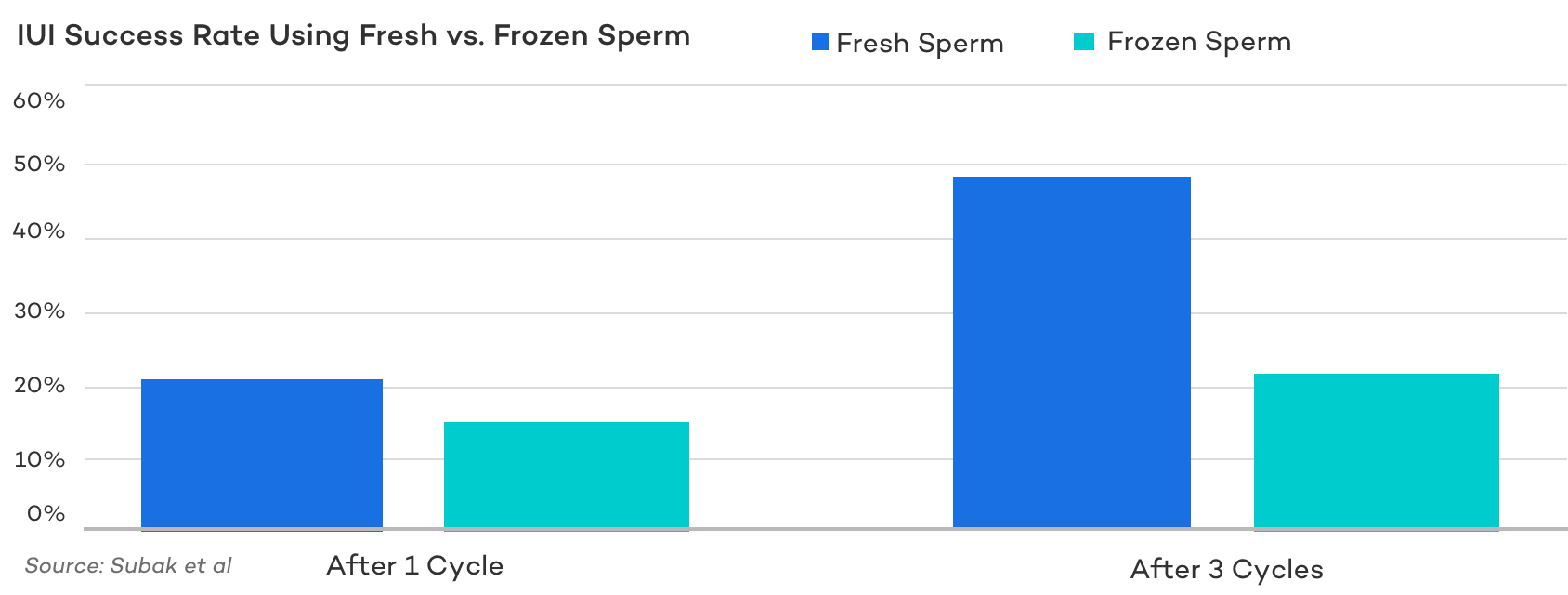
Fresh sperm isn’t always an option, particularly for LGBTQ couples, single women, those with severe male factor infertility, and those who have partners in active duty or otherwise may be unable to attend the fertility appointments and are thus using donor sperm. But that’s okay. Many fertility specialists would agree that the timing of the IUI and an adequate concentration of sperm, or total motile count (TMC), are really the more important factors.
IUI Success Based on Provider Type
You might wonder if IUI success rates vary depending on the type of health care provider who performs your insemination—whether it’s a nurse or doctor. In recent years, nurse practitioners and registered nurses have started to perform greater numbers of IUI procedures.
One study compared IUI success rates performed by a registered nurse, an attending physician, and a fellowship-trained physician and found no significant difference in pregnancy or live birth rates depending on who performed the insemination. While there are lots of factors that influence IUI success rates, provider type does not appear to be a significant one.
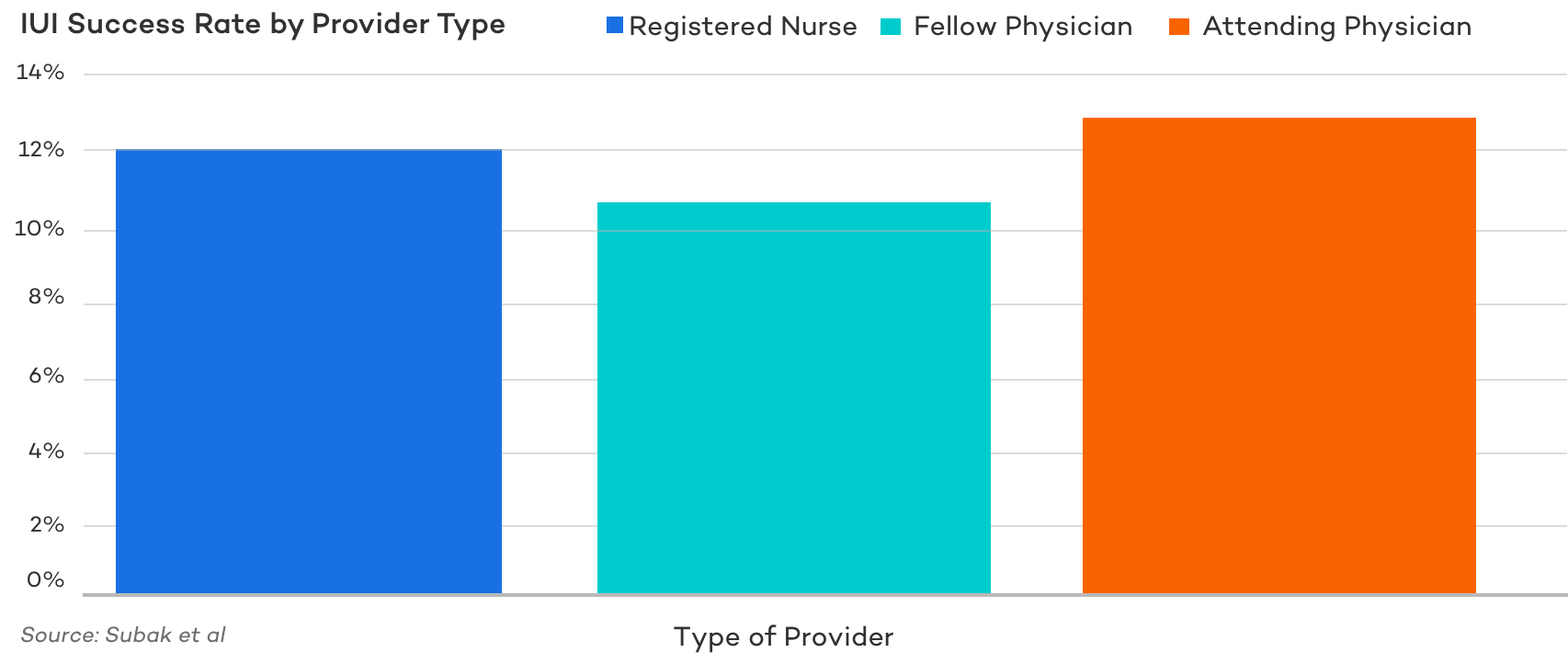
IUI Success Rates after Multiple Cycles
With natural conception, we tend to look at success over 6 months to a year of trying repeatedly month after month. That’s why fertility specialists suggest couples under the age of 35 try for 12 months on their own and couples over the age of 35 try for 6 months before seeking fertility assistance (less for women over 35 because as women age, it’s more important they seek help sooner). It’s the repetition that ensures success. This is somewhat true of IUI as well, but only up to a certain point. Statistics show that the majority of IUI pregnancies occur in the first three to four cycles of IUI. One study concluded that 88% of all successful IUIs happen within three cycles and 95% within four. Another study found that 90% of IUI pregnancies occur in the first three cycles of IUI.
Knowing when to move on to more advanced treatment like IVF is important for your emotional and financial well-being. If after 3-4 IUIs you have not been successful, success rates flatten out and it is statistically unlikely to work for you. At this point, the cost of IUI per live birth begins to skyrocket making IVF the more cost-effective treatment on a per live birth basis.

Considering Risk of Multiples as a Measure of IUI Success
IUI with paired with fertility medication carries a significant risk of multiple pregnancies. Although a good fertility clinic will carefully monitor your follicles, adjust medication as necessary, and cancel your IUI if you’re growing 4 or more follicles, they cannot entirely eliminate the risk. With IVF, you can choose how many embryos to transfer (one or potentially two is standard protocol). As a result, the risk of multiple pregnancies with IVF is much lower than it used to be, but IUI offers no such controls.
Ovarian stimulation used in tandem with IUI is designed to produce additional eggs to help boost the chances of conception. While your pregnancy chances do improve, so too does your likelihood of conceiving multiples. It is estimated that the risk of having twins while undergoing Clomid treatment is 10%, while the risk of triplets is less than 1%. On the other hand, women who take gonadotropins in conjunction with IUI have as much as a 30% chance for multiple and high-order pregnancies and births. Studies comparing the efficacy of various ovarian stimulation drugs can achieve widely different results due to the variability in dosages used in each study.
The good news is that while the chance of multiples per pregnancy can be high with IUI (8 – 30%) it varies significantly by medication and dosage – the multiples-per-pregnancy risk is higher in IUI cycles using gonadotropin than in Clomid or Letrozole IUI cycles. Also, it’s important to note that the overall risk per cycle is much lower than the risk per pregnancy, only 0.5 – 2.5% of IUI cycles actually result in multiple births.

How to Improve IUI Success Rates
Timing, egg quality, and sperm quality are pretty important when it comes to IUI. As we’ve seen, medicated cycle can significantly boost the number of eggs and improve IUI success rates. Most fertility specialists will recommend that you remain flat on your back immediately after your insemination. Research shows that women who lie down for fifteen minutes after the insemination can be 10% more likely to conceive during that cycle than those who got up immediately following the insemination.
In addition, changes to your lifestyle are some of the best ways to improve your overall health as you look to improve your chances of a successful IUI.
CNY Fertility recommends the following methods for increasing fertility prior to an IUI cycle:
- Eat fertility superfoods and high a fat, low-carb fertility diet to give your body all the nutrients it needs, reduce inflammation and improve hormone function.
- Take male and female fertility supplements to help enhance egg quality, sperm quality, improve implantation, and ultimately increase your odds of IUI success. Many nutrients you’ll find in fertility supplements including CoQ10/ubiquinol, inositol, Vitamin D, and more have been extensively studied and clinically shown to increase IUI success rates. Here at CNY Fertility, we recommend Molecular Fertility’s line of science-backed supplements for men and women.
- Limit high-intensity exercise which can cause heat and inflammation and take away blood flow from your core. Instead focus on yoga, Tai Chi, light weights and stretching, or walking with a friend.
- Certain prescription medications can further reduce inflammation beyond what changes to your diet and lifestyle can accomplish. If you’ve been diagnosed with PCOS or endometriosis, there are several drugs that are helpful in balancing hormones. If you have an overactive immune system, LDN, IVIG, and Tacrolimus can help dial it back. Infertility can be a result of other pre-existing conditions that can be treated to improve your chances of conception .
IVF vs. IUI Success Rates
When it comes time to compare treatment options, the comparison of IUI and IVF is by far the most talked about. There’s really no disputing the fact that statistically speaking In Vitro Fertilization (IVF) offers higher success rates and thus a quicker time to pregnancy than IUI, no matter your age or diagnosis. IVF techniques have significantly improved over the last two decades, but IUI success has remained largely unchanged. But IVF success comes at a cost—both physical, as IVF is a far more involved process than IUI requiring several different medications and surgical procedures—and financial. While IUI success rates approach IVF success rates after several repeated cycles, on a per cycle basis, IUI is many times less effective on a per cycle basis.
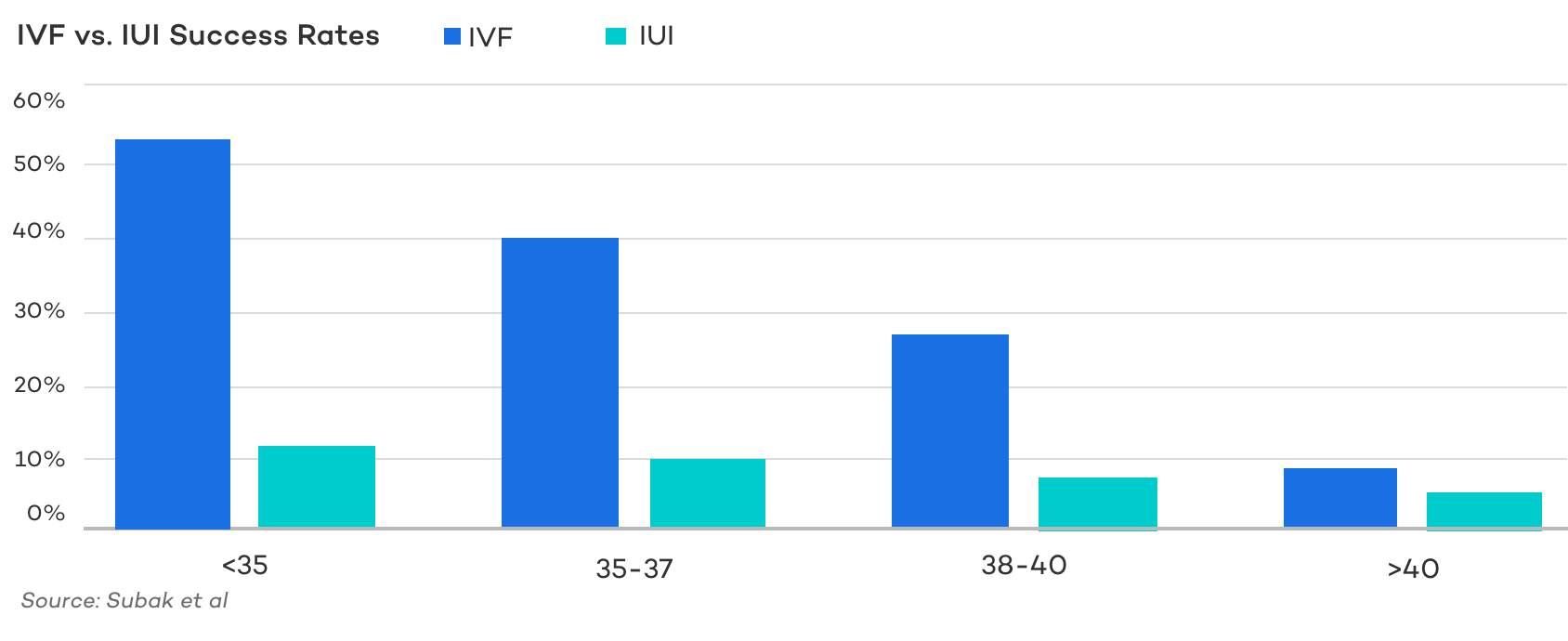
Rate of Multiples with IUI vs. IVF
For comparison purposes, how does the multiple birth rate for IVF compare to IUI?

According to a huge study of close to a million single embryo transfers, when a single embryo is transferred, there is just a 1.6% chance of a twin or multiple gestation birth that is a result of zygotic splitting. A second study of patients who had one blastocyst versus two blastocysts transferred found no difference in live birth rates, no incidence of twins in the single transfer group, and a twin birth rate of 29.02% for the double blastocyst group.
In the infancy of IVF, doctors had no way of knowing which of the embryos or how many embryos would survive and implant. To ensure success, they transferred more embryos. Now embryologists have cutting edge technology and techniques to better assess and ensure embryo quality. For the health of both mother and baby, the goal is always to have one healthy baby at a time.
ASRM recommends a single embryo transfer (eSET) in all patients under 38 years of age as well as all PGT euploid embryos. eSET offers a reduced chance of multiples while maintaining a very similar rate of pregnancy. Because doctors are transferring fewer embryos with each IVF cycle, multiple births are not as frequent as they were several years ago.
It’s only when you electively transfer more than one embryo that multiple birth rates with IVF become comparable to the multiple birth rates of IUI.
IUI Success Stories
When you’re trying to get pregnant, nothing boosts hope like hearing the IUI success stories of others who’ve gone through similar struggles and ultimately been successful at bringing a child into this world. While IUI doesn’t always work the first try and may require a bit of patience or a change in protocol, it does work, and we’ve got the success stories to prove it!
- Read about how Danielle and Joseph overcame PCOS by eating keto and doing medicated IUI.
- Learn how Candice and Patrick incorporated acupuncture, Maya massage, and keto along with IUI and Letrozole to welcome their rainbow baby.
- Cristine and Mervin used medicated IUI to beat male factor infertility and welcome their son, Mervy.
- Ramona and Stepan combined conceived their oldest son Zayn with IUI. Ramona switched to keto and was able to conceive their younger son Iden naturally.
- Christine and Sam switched to IUI with injectables for their second IUI cycle and successfully conceived triplets- Viola, John Henry, and Vivienne.
Bottom Line
IUI or artificial insemination is one of the least invasive fertility treatments out there and can be pretty successful in certain situations. IUI is a good starting treatment for many women and couples, particularly those with mild male factor infertility and/or ovulatory dysfunction or unexplained infertility and same sex or single women. Your likelihood for success depends on many factors, most importantly your age, diagnosis, and the medication protocol used.



